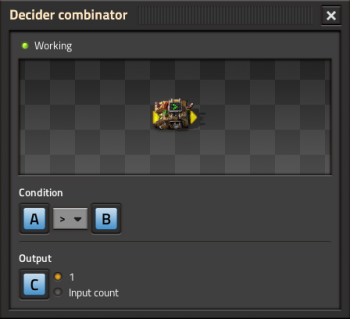Decider combinator
| Decider combinator |
|
Recipe |
|||||||||||||
| ++ → | |||||||||||||
|
Total raw |
|||||||||||||
| ++ | |||||||||||||
|
Map color |
|||||||||||||
|
Health |
|
||||||||||||
|
Stack size |
50 |
||||||||||||
|
50 (1 stack) |
|||||||||||||
|
Energy consumption |
1 kw (electric) |
||||||||||||
|
Mining time |
0.1 |
||||||||||||
|
Prototype type |
|||||||||||||
|
Internal name |
decider-combinator |
||||||||||||
|
Required technologies |
|||||||||||||
|
Produced by |
|||||||||||||
|
Consumed by |
|||||||||||||
The Decider combinator is part of the circuit network and one of three types of combinators available in the game (with the other two being the constant combinator and arithmetic combinator). It is used to make comparisons of signals on the network. Signals can be compared using
- "is greater than" (>)
- "is less than" (<)
- "greater than or equal to" (>=)
- "less than or equal to" (<=)
- "is equal to" (=)
- "is not equal to" (!=)
Input contacts are to the left in the picture below, outputs on the right.
Function
The internal logic process has three steps:
- Values for each individual input signal(s) (items of the same name) on the red and green wires are summed within the combinator.
- The decider combinator GUI specifies a "first" input signal, a comparison (>, <, =, >=, <=, !=), and a "second" input signal or constant.
- If the comparison returns true, the output is one or more signals with a value of 1 or the unchanged input value(s), or a single signal carrying either a sum of input signals or the number of passed tests. (see table below)
The decider combinator can handle logic signals.
Further notes:
- Using the Everything output with "Input count" will pass all non-zero input values to the output as long as the condition is true. Using the Everything output with "1" will output 1 ONLY for all non-zero inputs.
- The Each input will re-apply the comparison for each input signal individually, and will pass the selected output for each input that passes the conditional.
- The Everything input functions as a logical AND, and will return true only if ALL non-zero inputs pass the conditional, and returns true if there are no inputs at all (so "everything ≠ 0" always passes).
- The Anything input functions as a logical OR, and will return true if ANY non-zero input passes the conditional, and returns false if there are no inputs at all (so "anything = 0" always fails).
- When "Input Count" is selected the output will match the input for the selected signal if the first parameter is not Each. If the first parameter is Each then "Input Count" refers to the value of the input signal that is currently being iterated, so the result will be the sum of all inputs if the output signal is not Each. If the output signal is also Each then every input signal that passes the test is simply forwarded while those that fail the test are discarded.
The following table shows how different combinations of the first input parameter and the output can be used.
| ↓Output Input→ | Each | Anything, Everything, or a specific signal |
|---|---|---|
| Everything: 1 | - | every input signal is forwarded but set to 1 |
| Everything: Input count | every input signal is forwarded | |
| Specific signal: 1 | number of input signals† | the specific signal with value 1 |
| Specific signal: Input count | sum of inputs† | the specific signal is forwarded |
| Each: 1 | each input signal† is forwarded but set to 1 | - |
| Each: Input count | each input signal† is forwarded |
† signals that passed the test only
With both the arithmetic and decider combinator, there is one tick (60th of a second) of latency before the output signal is ready to be used as an input into a circuit network.
History
- 0.15.0:
- Added additional operators to the Decider Combinator and Circuit Conditions.
- 0.13.0:
- Connected wires are highlighted when hovering over a combinator connected to the circuit network.
- Combinators show input and output in alt mode.
- More virtual signals for combinators.
- Constant combinator can be rotated.
- Decider combinator "input count" option makes the combinator copy the count of the specified output signal from the input signals, instead of copying the count from the condition.
- New combinator graphics.
- 0.12.5:
- Combinators now emit light.
- 0.12.2:
- Combinators no longer turn off when no wires are connected.
- 0.12.0:
- Introduced
See Also
- Arithmetic combinator
- Constant combinator
- Combinator tutorial (description of combinator logic gates)
- Circuit network
- Circuit network cookbook

